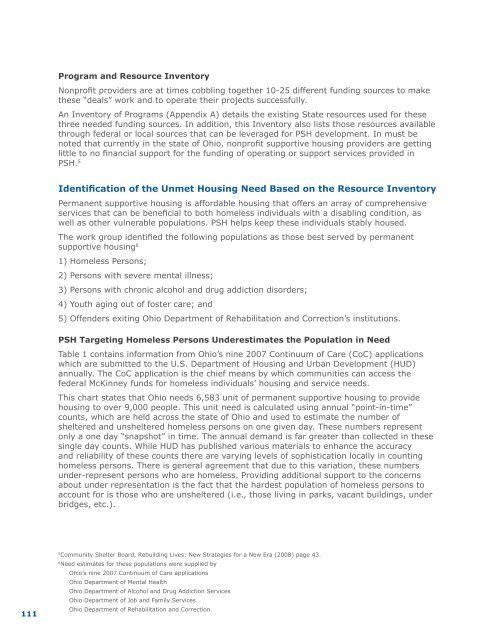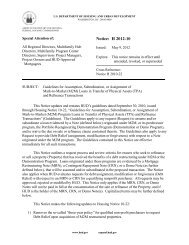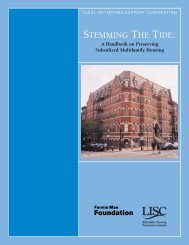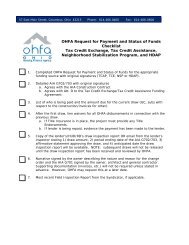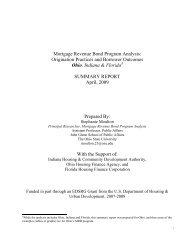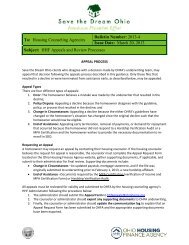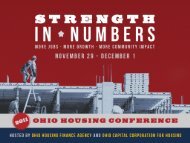Identification of the Met <strong>Housing</strong> NeedBackground“Those who favor independent housing believe that housing should be viewed “as a placeto live, not a place to be treated” (<strong>Ohio</strong> Department of Mental Health 1988). Two basicprinciples underlie this perspective. First, the need for housing remains constant overa person’s lifetime, while the need for services varies. Second, only by disentanglinghousing from services will it be possible to create a system in which services are designedto support the person in housing instead of developing housing programs to facilitatetreatment or services (<strong>Ohio</strong> Department of Mental Health 1988).” 2Permanent supportive housing (PSH) had its beginnings in <strong>Ohio</strong> in the late 1980’s due tothe combined efforts of the <strong>Ohio</strong> Department of Mental Health, local mental health boardsand their nonprofit housing developers. Their efforts were in response to the rising need forcommunity based housing and services, due in part to the deinstitutionalization of personswith mental illness and the lack of appropriate housing options for consumers of mentalhealth services. 3In the 1980’s, due to a national economic downturn and a large loss of affordablerental housing (primarily single room occupancy units), the country saw an explosion ofhomelessness. Among those individuals and families who were homeless, was an alarmingfind – people with disabling conditions such as mental illness were far more likely to behomeless for long periods of time - months and even years. In response, the federalgovernment enacted the McKinney-Vento Homeless Assistance Act of 1986. This legislationprovided new dollars, which furthered the development of transitional and permanenthousing with services for homeless people, targeting those with disabling conditions,including mental illness.Creation of PSH in <strong>Ohio</strong>In <strong>Ohio</strong>, it is difficult to determine the exact number of permanent supportive housing unitscreated since the late 1980’s as a result of ODMH, local mental health Board and federalMcKinney investment. It is estimated that as of 2007 <strong>Ohio</strong> has at a minimum 8,000 to 8,500units of permanent supportive housing scattered throughout the state, with a concentrationin urban counties. 4The nonprofit housing developers and permanent supportive housing providers havehistorically been challenged in developing these units. The creation and operationof permanent supportive housing requires funding for three distinct and necessarycomponents: 1) Capital to acquire property, rehabilitate existing units, and/or to constructnew units; 2) Operating subsidies to offset the rents which are usually beyond the abilityof most tenants to pay (generally tenants in PSH are at or below 30 percent of AMI) or tocover the cost of having security and support at the front door of an apartment building;and 3) Service funding which pays for the staff which assists the tenants in accessing andutilizing community based services such as treatment.2Joseph Harkness, Sandra J Newman, and David Salkever; The Cost-Effectiveness of Independent <strong>Housing</strong> for the ChronicallyMentally Ill: Do <strong>Housing</strong> and Neighborhood Features Matter?(2004) Available Internet: http://www.pubmedcentral.nih.gov/articlerender.fcgi?artid=13610733In 1963, the Community Mental Health Centers (CMHC) Act was passed and policymakers viewed this legislation as drivingdeinstitutionalization by shifting treatment for people with severe mental illness (SMI) from state mental hospitals to “leastrestrictive environments” within the communities. Initially, this Act was not directly responsible for homelessness due to the higherfunctionality patients in the early releases. When further laws were changed, including the Lanterman-Petris-Short Act of 1967,which restricted involuntary hospitalizations, and the country experienced an economic downturn and a reduction in affordablehousing, the demand for housing with support services for the mentally ill increased.4Corporation for Supportive <strong>Housing</strong>, <strong>Ohio</strong> Permanent Supportive <strong>Housing</strong> Inventory (2008) available Internet: http://www.csh.org/index.cfm?fuseaction=Page.viewPage&pageId=4212&nodeID=87110
Program and Resource InventoryNonprofit providers are at times cobbling together 10-25 different funding sources to makethese “deals” work and to operate their projects successfully.An Inventory of Programs (Appendix A) details the existing State resources used for thesethree needed funding sources. In addition, this Inventory also lists those resources availablethrough federal or local sources that can be leveraged for PSH development. In must benoted that currently in the state of <strong>Ohio</strong>, nonprofit supportive housing providers are gettinglittle to no financial support for the funding of operating or support services provided inPSH. 5Identification of the Unmet <strong>Housing</strong> Need Based on the Resource InventoryPermanent supportive housing is affordable housing that offers an array of comprehensiveservices that can be beneficial to both homeless individuals with a disabling condition, aswell as other vulnerable populations. PSH helps keep these individuals stably housed.The work group identified the following populations as those best served by permanentsupportive housing 61) Homeless Persons;2) Persons with severe mental illness;3) Persons with chronic alcohol and drug addiction disorders;4) Youth aging out of foster care; and5) Offenders exiting <strong>Ohio</strong> Department of Rehabilitation and Correction’s institutions.PSH Targeting Homeless Persons Underestimates the Population in NeedTable 1 contains information from <strong>Ohio</strong>’s nine 2007 Continuum of Care (CoC) applicationswhich are submitted to the U.S. Department of <strong>Housing</strong> and Urban Development (HUD)annually. The CoC application is the chief means by which communities can access thefederal McKinney funds for homeless individuals’ housing and service needs.This chart states that <strong>Ohio</strong> needs 6,583 unit of permanent supportive housing to providehousing to over 9,000 people. This unit need is calculated using annual “point-in-time”counts, which are held across the state of <strong>Ohio</strong> and used to estimate the number ofsheltered and unsheltered homeless persons on one given day. These numbers representonly a one day “snapshot” in time. The annual demand is far greater than collected in thesesingle day counts. While HUD has published various materials to enhance the accuracyand reliability of these counts there are varying levels of sophistication locally in countinghomeless persons. There is general agreement that due to this variation, these numbersunder-represent persons who are homeless. Providing additional support to the concernsabout under representation is the fact that the hardest population of homeless persons toaccount for is those who are unsheltered (i.e., those living in parks, vacant buildings, underbridges, etc.).5Community Shelter Board, Rebuilding Lives: New Strategies for a New Era (2008) page 43.6Need estimates for these populations were supplied by111<strong>Ohio</strong>’s nine 2007 Continuum of Care applications<strong>Ohio</strong> Department of Mental Health<strong>Ohio</strong> Department of Alcohol and Drug Addiction Services<strong>Ohio</strong> Department of Job and Family Services<strong>Ohio</strong> Department of Rehabilitation and Correction.
- Page 3 and 4:
OHFA Annual PlanThe Ohio Housing Fi
- Page 5:
Mission StatementsThe OHFA Annual P
- Page 8 and 9:
The State’s Housing NeedsAffordab
- Page 10 and 11:
Subject Matter Expert (SME) Workgro
- Page 12 and 13:
3. Financial LiteracyOHFA and other
- Page 14 and 15:
Affordable Housing Preservation & D
- Page 16 and 17:
federal subsidies. To achieve this
- Page 18 and 19:
Accessible HousingBackground DataOh
- Page 20 and 21:
3) Create dedicated funding streams
- Page 22 and 23:
• Recommend that Ohio support the
- Page 24 and 25:
Rural and Appalachian RegionsBackgr
- Page 26 and 27:
6. Annual Set-Asides and Incentives
- Page 28 and 29:
• Several cities in Ohio current
- Page 30 and 31:
OHFA should provide funding, traini
- Page 32 and 33:
Permanent Supportive Housing Produc
- Page 34 and 35:
3. The State should assist local Co
- Page 45 and 46:
PrioritizationThe challenge of prio
- Page 47 and 48:
Agency RecommendationsThe Annual Pl
- Page 49 and 50:
APPENDIXWorkgroup 1: Affordable Hom
- Page 51 and 52:
Executive SummaryHousing Need Descr
- Page 53 and 54:
efficiency and resource conservatio
- Page 55 and 56:
554. Home Buyer Education in OHFA F
- Page 57 and 58:
Estimated Units in Need of Some For
- Page 59 and 60: Ohio County Foreclosure Filings (19
- Page 61 and 62: Operating Costs - Met and Unmet Nee
- Page 63 and 64: Workgroup #2:Affordable Housing Pre
- Page 65 and 66: Secondary Recommendations• Explor
- Page 67 and 68: Executive SummaryOhio’s supply of
- Page 69 and 70: Met Housing Needs (“Resource Inve
- Page 71 and 72: Ohio Deptof MentalRetardation andDe
- Page 73 and 74: Unmet Housing NeedsData OverviewThe
- Page 75 and 76: ody, and will be built within the C
- Page 77 and 78: • OHFA will continue to maintain
- Page 79 and 80: Best Practices, Policies and Progra
- Page 81 and 82: addition, 60,111 one-person househo
- Page 83 and 84: Across Ohio, people with very low i
- Page 85 and 86: • Responsible for Rent - The pers
- Page 87 and 88: Seattle, St. Louis, and Washington,
- Page 89 and 90: Primary Recommendations• Create a
- Page 91 and 92: Unmet Housing Needs:• Due to the
- Page 93 and 94: • The cost of construction often
- Page 95 and 96: Recommendations for Annual Plan Adv
- Page 97 and 98: capacity to quantify vacant propert
- Page 99 and 100: distributed on or about January 15,
- Page 101 and 102: Action is needed at the State level
- Page 103 and 104: a “user-friendly” data system,
- Page 105 and 106: 5) Incentivize the formation of bro
- Page 107 and 108: Workgroup #8:Permanent Supportive H
- Page 109: 3. Assist local Continuums of Care
- Page 113 and 114: Table 2PopulationsPersons whoexperi
- Page 115 and 116: Examples: A national model for succ
- Page 117 and 118: oles, so they create a contract bet
- Page 119 and 120: Workgroup #8:Appendix ANameProgramD
- Page 121 and 122: or remedyingneglect, abuse,or the e
- Page 123 and 124: ased healthcare, and earlyintervent
- Page 125 and 126: “Bob” of Stark County, OhioPubl


